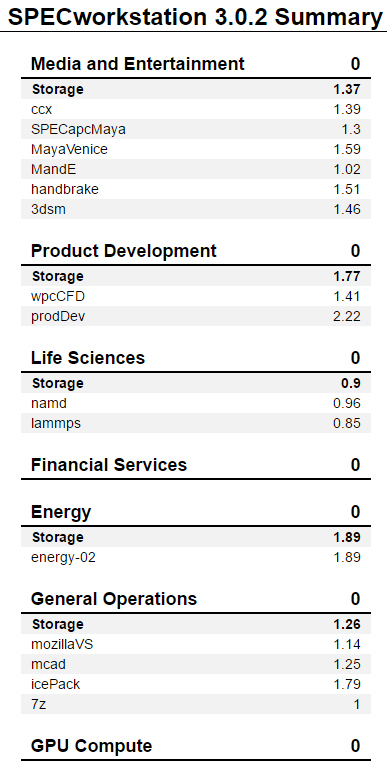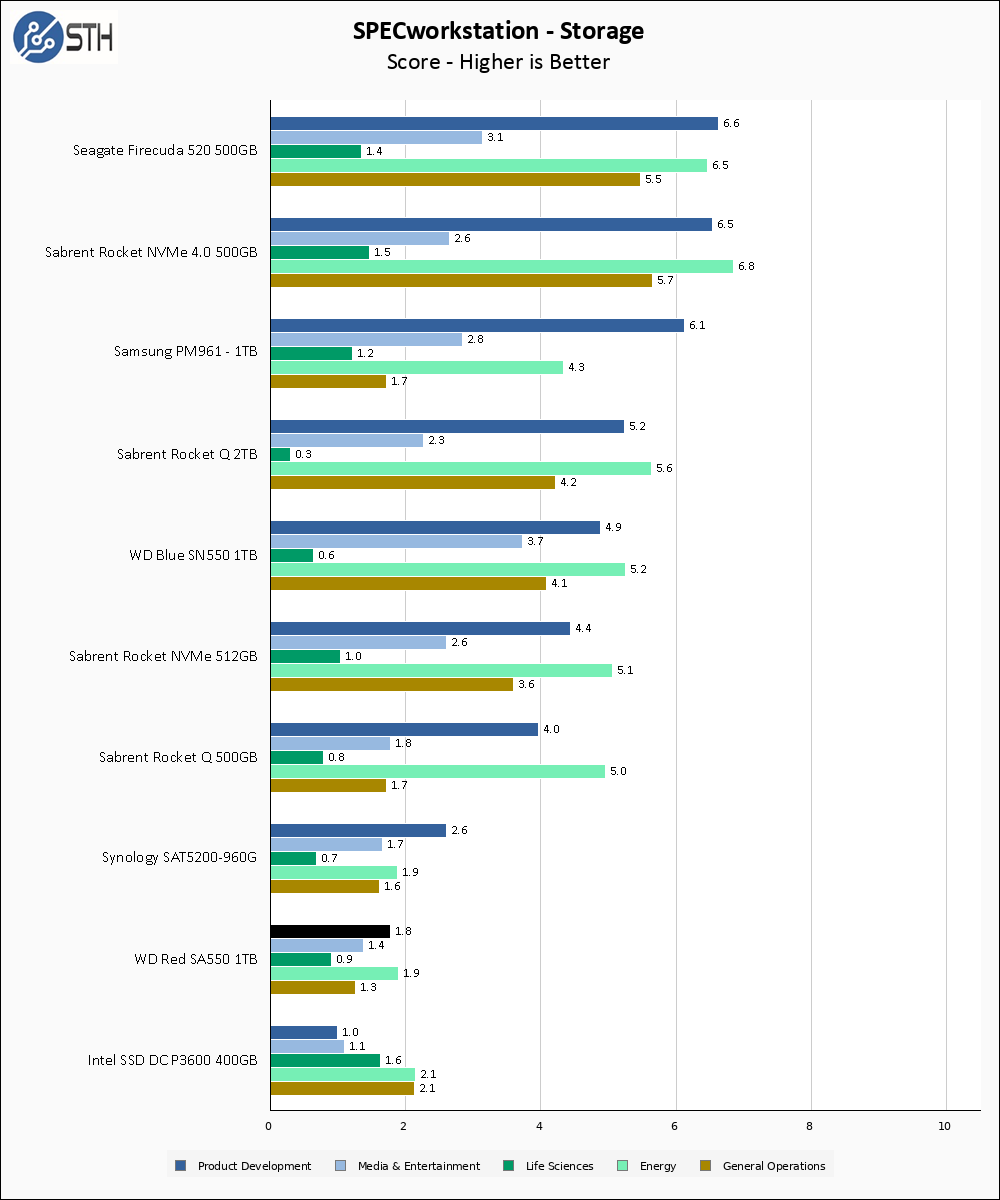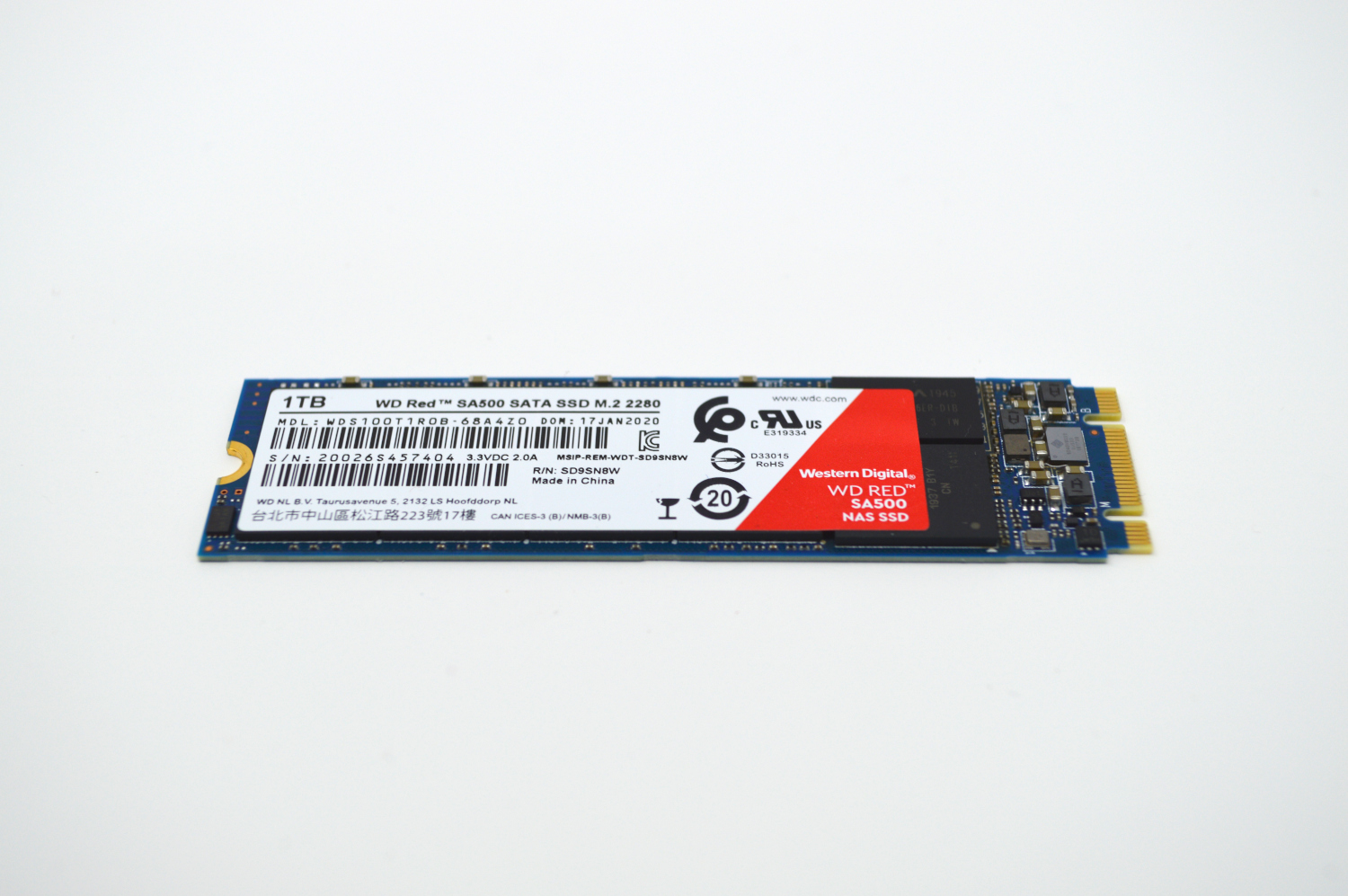SPECworkstation 3.0.2 Storage Benchmark
SPECworstation benchmark is an excellent benchmark to test systems using workstation type workloads. In this test, we only ran the Storage component, which is 15 separate tests.


The WD Red SA500 1TB does not do particularly well in this test, except for the Life Sciences category where it manages a win over a handful of other drives.
Temperatures
We monitored the idle and maximum temperature during testing with HWMonitor to get some idea of the thermal performance and requirements of the drive. Please keep in mind that our test bench is an open frame chassis in a 22C room, and is thus not representative of a cramped low-airflow case.

As we suspected earlier, the SATA nature of the drive prevents both the NAND and controller from stressing out too much, leading to lower temperatures. 58C under sustained load is downright chilly compared to some other drives we have tested.
Final Words
The WD Red SA500 1TB is available for approximately $130 online, and theoretically competes with the Synology SAT5200-960G and Seagate Ironwolf 110 960GB drives for placement in NAS systems. However, those drives are significantly more expensive and have a much more enterprise-focused feature set, since they come with significant over-provisioning and power loss protection, both of which the SA500 1TB lacks. With that said, the Synology and Seagate drives are significantly more expensive than the WD Red drive, so an argument could be made for cost savings.

Overall, the WD Red SA500 1TB drive strikes an odd impression; it does not feel much like a NAS focused SSD. Instead, it seems more like a standard consumer SSD that has just been given a coat of Red paint. Compared to the more purpose-designed choices of the Synology SAT5200 and Seagate Ironwolf 110 drives, the WD Red SA500 seems quite pedestrian. It is much less expensive, but just as we said in the SA5200 review – you get what you pay for. Given the feature set delta, we feel this is similar to how WD Red was found to use SMR and forced WD to introduce the Red Plus. The Seagate and Synology drives feel like premium offerings while the WD Red brand is being pushed down market with lower-end features than its competitors.
If you need low-cost SSD drives for your NAS and do not require the enterprise features of more expensive drives, then perhaps the WD Red SA500 is a solid option.




Western Digital isn’t really helping their Red brand. First with sneaking SMR drives into NAS drives, now releasing a enterprise NAS branded SSD that lacks enterprise features. What is WD doing?
@Steven – I think they are reshuffling their brands. Red is now “prosumer” and red pro is is getting closer to enterprise, although gold is obviously the true enterprise in their weird colour based system.
This drive doesn’t seem compelling at all.
It’s hard to think of a use case where I would be excited to get this drive, even for $120.
Sata-only, so, it’s not fast, but, that does improve compatibility I suppose.
0.6 DWPD, so, not a ton of endurance, but not the worst I’ve seen I guess.
No PLP, which makes it not great for a number of use cases.
$120 for 1tb, so, I can get a used enterprise drive with PLP, high endurance, higher performance, around the same size, for around the same price.
Like an 800gb or 1.6tb Intel DC S3600, I’d much rather have one of those for 2.5″ form factor at least. Don’t know off the top of my head what m.2 drive I’d rather have, but, in m.2 form factor I’d really prefer nvme.
It seems computer storage technology has experienced a Christensen type of disruptive innovation. Companies such as Western Digital and Seagate were too busy making money with traditional hard disks (and shingled magnetic recording) to invest in the future. The too little too late mode of operation that happens in such situations then results in thoroughly underwhelming products which have no compelling advantage over similar things that were on the market years ago. I see no market leadership whatsoever in bringing a SATA m.2 drive to market at this point.
Slow SATA drives being so close in price to proper NVMe drives is really infuriating.
This sounds like Boeing renaming the 777X to the 777MAX.
I was happy to see the “you get what you pay for” quote for this SSD, as i basicly bougth the cheapest ssds of a trusted vendor.
I’m using 4 of these in my silent qnap nas (2x m.2, 2×2.5″) and they max out at 680Mbyte/s over 10GbE.
Thanks for the review.
This is a typo, yes? “Seagate WD Red SA500 Specs”
To demonstrate market leadership, I would recommend that WDC consider advocating a new “SATA-IV” standard that adds at least 2 more features:
(1) change the frame layout from 8b/10b “legacy frame” to 128b/130b “jumbo frame”
(PCIe/NVMe channels already do this);
(2) sync the clock rate to the chipset, using auto detection as needed
(NVMe already uses 8G (Gen3) and 16G (Gen4)).
Modern SATA SSDs e.g. Samsung, WDC etc. already “down-clock” to accommodate
slower SATA ports e.g. 3G (SATA-II) and even 1.5G (SATA-I).
SATA-IV should default to 16G, to sync it with PCIe 4.0 chipsets
and be backward-compatible with 8G, 6G, 3G and 1.5G clock rates.
16G / 8.125 = 1,969.2 MB/second per SATA-IV channel
6G / 10 = 600 MB/second per SATA-III channel
By definition, “SATA” uses a single Serial channel (the “S” in “SATA”);
NVMe by design uses x2 or x4 PCIe lanes.
Freezing SATA at 6G and the 8b/10b legacy frame is only retarding
the normal evolution of this one technology.
p.s. for readers who are not familiar with frame layouts:
“legacy frame” is one start bit + 8 data bits + one stop bit
for a total of 10 binary digits per byte
(6G / 10 = 600 MB/sec MAX HEADROOM = theoretical maximum bandwidth)
“jumbo frame” is one start bit + 16 bytes @ 8 bits per byte + one stop bit
for a total of 130 binary digits per 16 bytes = 130 / 16 = 8.125 bits per byte
(8G / 8.125) = 984.6 MB/sec MAX HEADROOM)
Hope this helps.